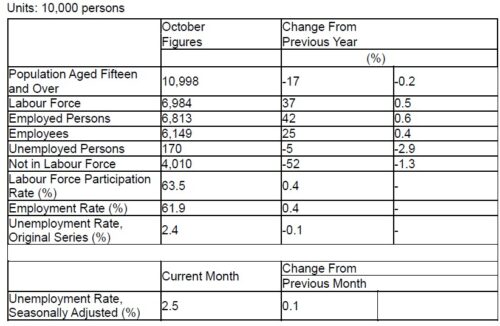Economic and Labour Situation in Japan, December 2024
First Tripartite Conference under the Ishiba Administration
On November 26, the government held a tripartite conference at the Prime Minister’s Office, bringing together representatives from the government, the business community, and labor unions, as reported in our email magazine No. 431. Prime Minister Shigeru Ishiba called for “cooperation in achieving substantial wage increases with the momentum of this year’s historic wage hikes, the highest in 33 years,” in preparation for next year’s spring labor negotiations. Regarding the government’s policy to raise the national average minimum hourly wage to 1,500 yen by the 2020s, measures are set to be formulated by next spring. However, as this represents an increase of 40% or more over the current level, cautious opinions were expressed by the business community.
This was the first tripartite conference under the Ishiba administration. The meeting was attended by Masakazu Tokura, chairman of the Japan Business Federation (Keidanren), Ken Kobayashi, chairman of the Japan Chamber of Commerce and Industry, and Tomoko Yoshino, president of the Japanese Trade Union Confederation (Rengo), among others. The Prime Minister emphasized, “It is crucial that the flow of wage increases reaches everyone working in small and medium-sized enterprises and in local regions, which account for 70% of employment.”
Labour Force Survey Monthly Results*1
The number of employed women increased, while the number of employed men decreased, in October.
(1) Employment
The number of employed persons in October 2024 was 68.13 million, an increase of 420,000 over the same month the previous year. By gender, this included 37.04 million men, down 40,000, and 31.09 million women, up 460,000 over the previous year.
(2) Unemployment
The number of unemployed persons in October 2024 was 1.70 million, a decrease of 50,000 from the same month in the previous year.
The seasonally adjusted unemployment rate in October was 2.5%, up 0.1 point over the previous month. The unemployment rate for men was 2.8%, up 0.1 point over the previous month, and for women 2.1%, unchanged from the previous month.

(3) Job Availability
Japan’s job availability in October stood at 1.25, up 0.01 point over the previous month. This ratio means there were 125 job openings for every 100 job seekers.
The ratio of regular employee job offers to applicants was 1.02, up 0.01 point from the previous month.
The ratio of new job offers to applicants, a leading indicator for the labour market, was 2.24, up 0.02 points over the previous month. The number of new job offers increased 1.2%. By industry, scientific research professional and technical services and information and communications increased 8.9% and 6.4% respectively, while accommodation, eating and drinking services and education and learning support services dropped 6.5% and 4.9%, respectively.
Industrial Production*2
Industrial output in October increased 3.0% over the previous month, propped up by strong exports of semiconductor manufacturing equipment and motor vehicles.
Production and shipments increased, while inventories and inventory ratio decreased. The industries that mainly contributed to this increase were as follows: (1) production machinery; (2) motor vehicles; and (3) fabricated metals, in that order.
According to the Survey of Production Forecasts in Manufacturing, production was expected to decrease 2.2% in November and decrease 0.5% in December.

Family Income and Expenditure Survey *3
(1) Expenditure of Households of Two Persons or More
Average monthly consumption expenditure of households of two or more persons in October was 305,819 yen, up 1.3% in nominal terms but down 1.3% in real terms from the previous year, falling for the third straight month, by consumers cutting outlays on food amid higher prices.
(2) Income and Expenditures for Workers’ Households
Average monthly income per household stood at 580,675 yen, up 3.7% in nominal terms and up 1.1% in real terms from the previous year. The average level of consumption expenditure was 327,613 yen per month, down 0.9% in nominal terms and down 3.4% in real terms year-on-year.
Consumer Prices *4
The consumer price index (CPI) in October was 109.5 (2020 = 100), up 2.3% over the previous year and up 0.4% over the previous month. Core inflation (CPI less food and energy) was up 2.3% over the previous year and up 0.4% over the previous month, increasing at a slower pace for the second straight month as government subsidies curbed a rise in energy bills. Excluding the effects of the government subsidies, the data likely suggest underlying inflation is persistent.
Prices for rice, Japan’s staple food, soared 60.33% over the previous year, the highest increase in nearly 49 years, due to short supply following last year’s hot summer and higher demand from restaurants.

<Y.A>
- Source: Labour Force Survey Monthly Results (Statistics Bureau of Japan)
https://www.stat.go.jp/english/data/roudou/results/month/index.html - Source: Indices of Industrial Production (Ministry of Economy, Trade and Industry)
https://www.meti.go.jp/english/statistics/tyo/iip/index.html - Source: Summary of the Latest Month on Family Income and Expenditure Survey (Statistics Bureau of Japan)
https://www.stat.go.jp/english/data/kakei/156.html - Source: Consumer Price Index (Statistics Bureau of Japan)
https://www.stat.go.jp/english/data/cpi/1581-z.html
